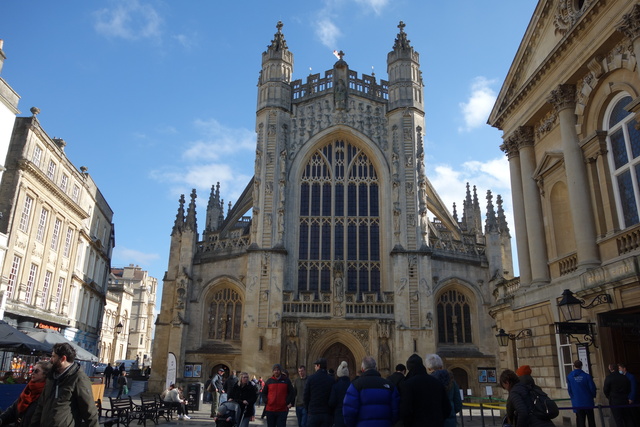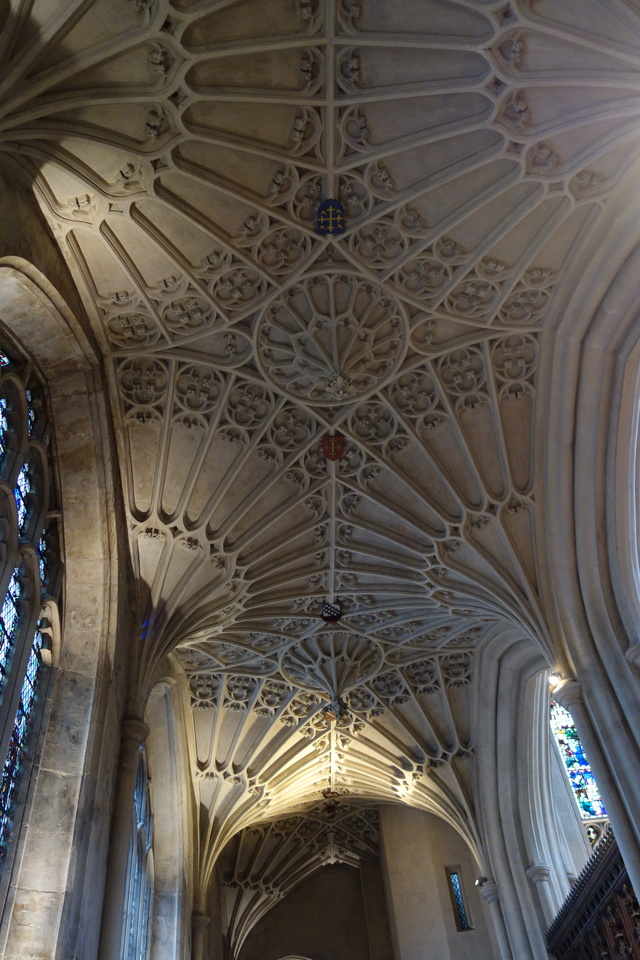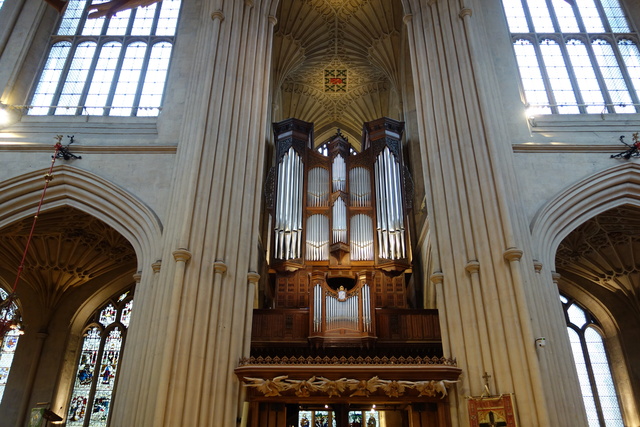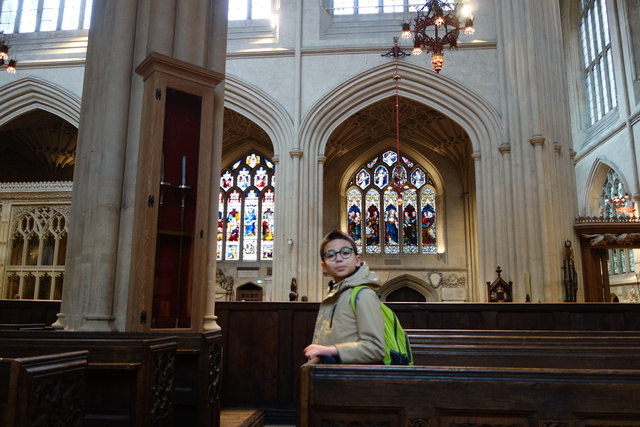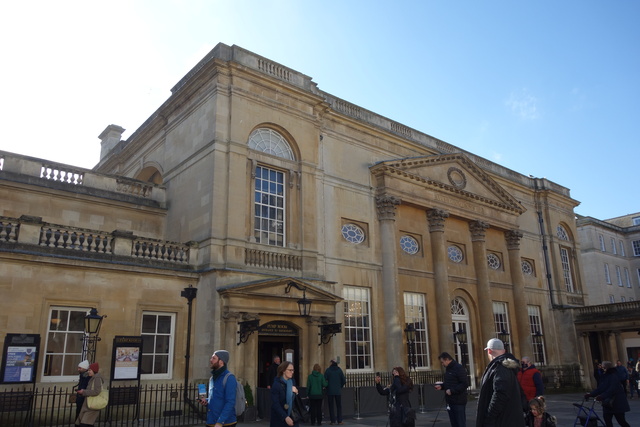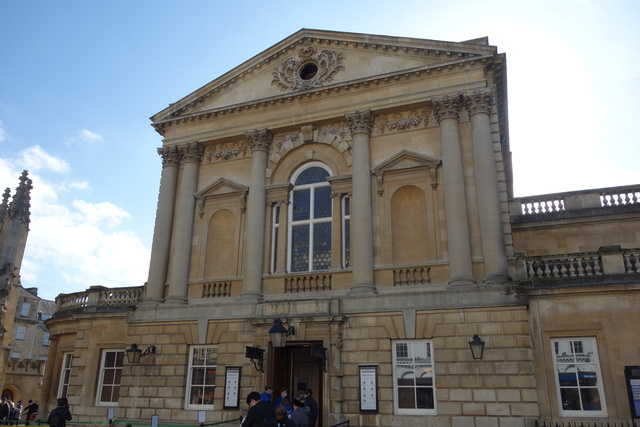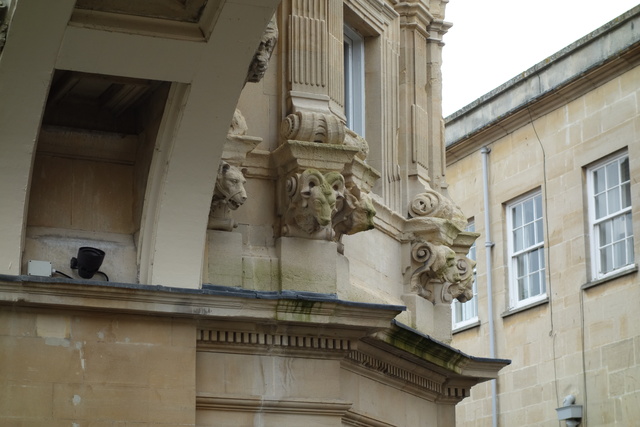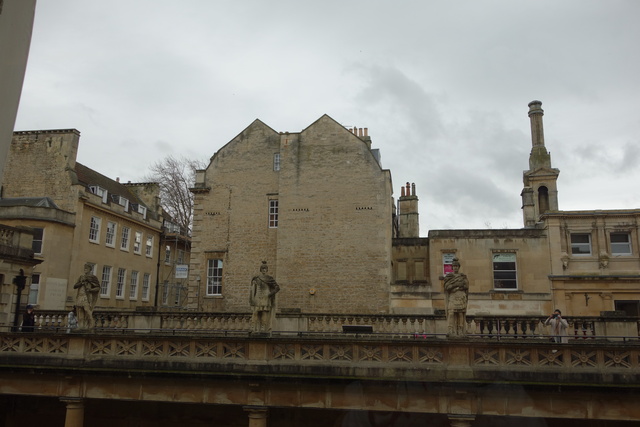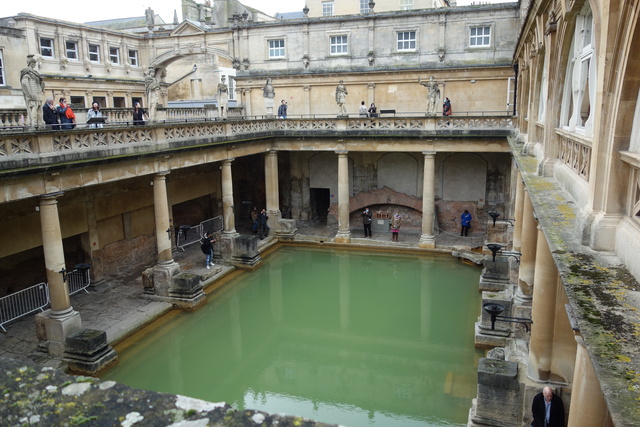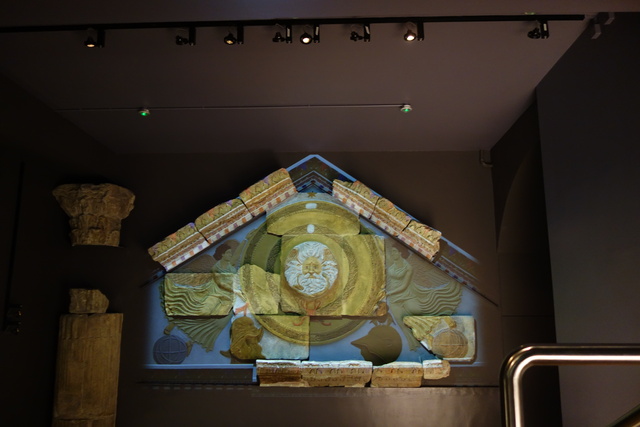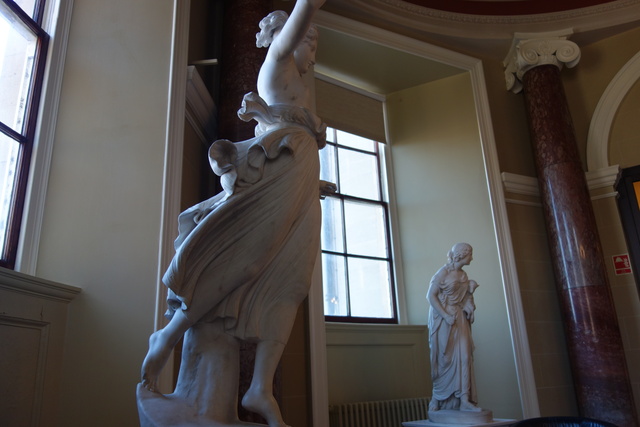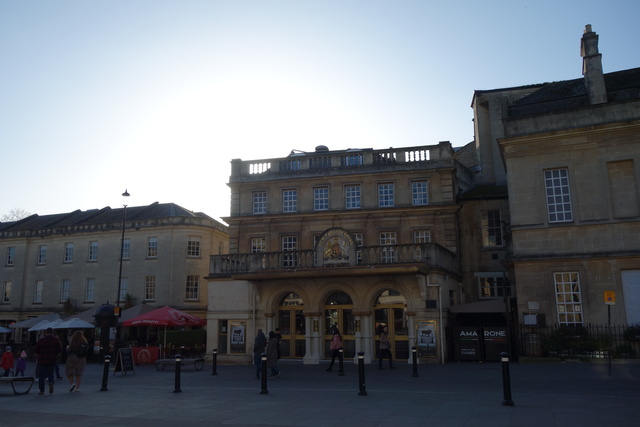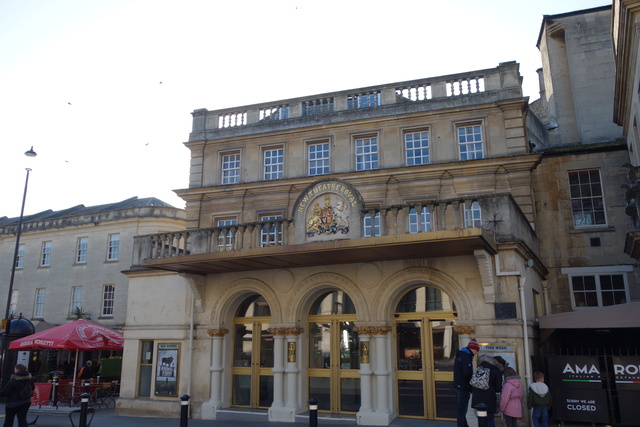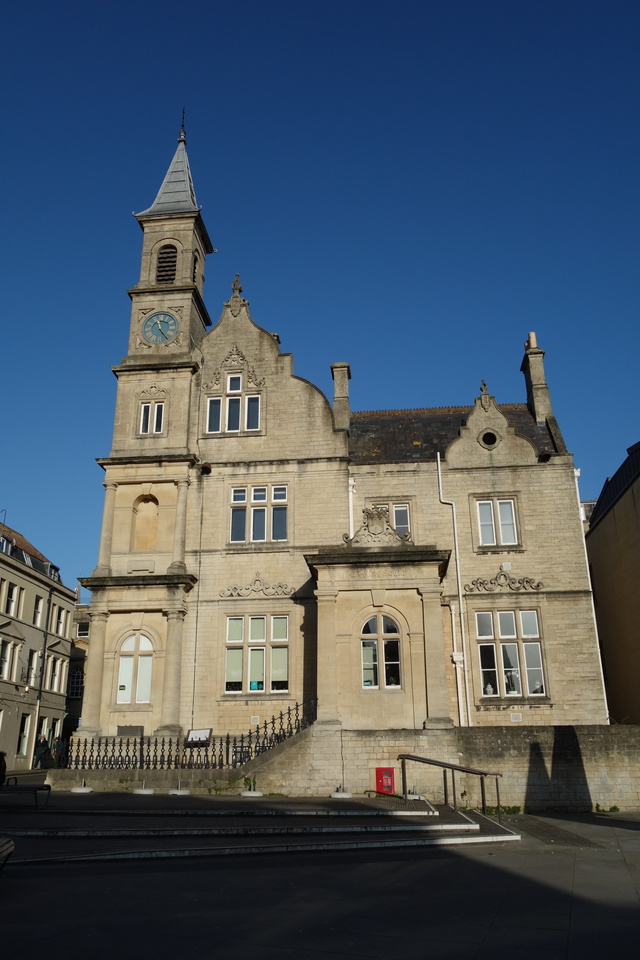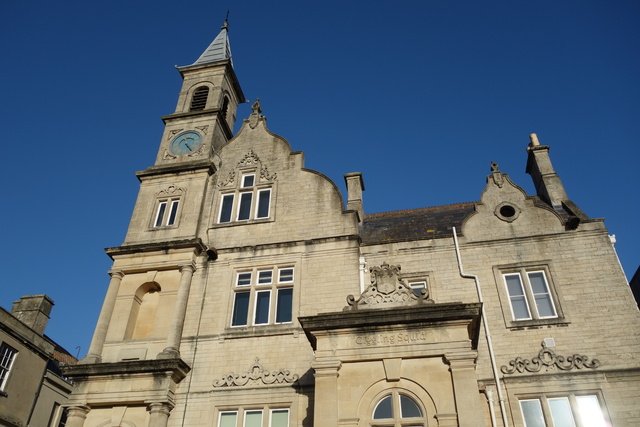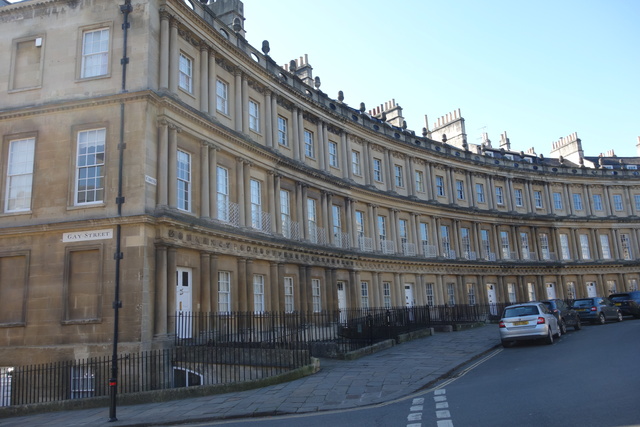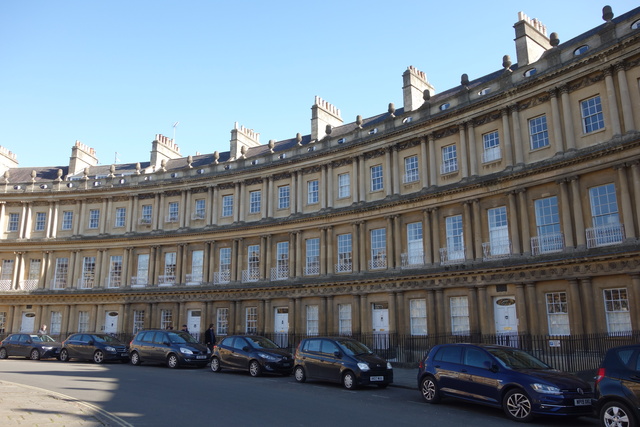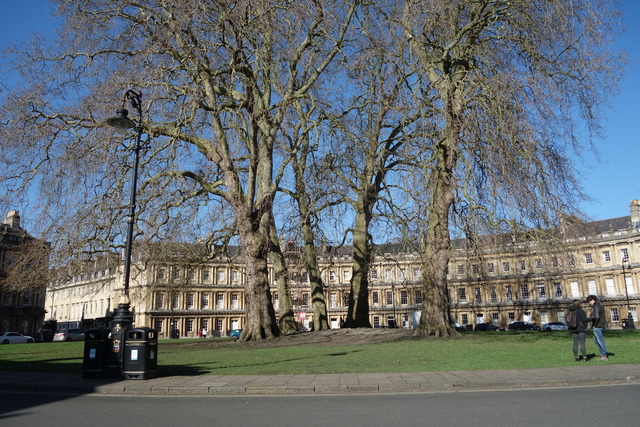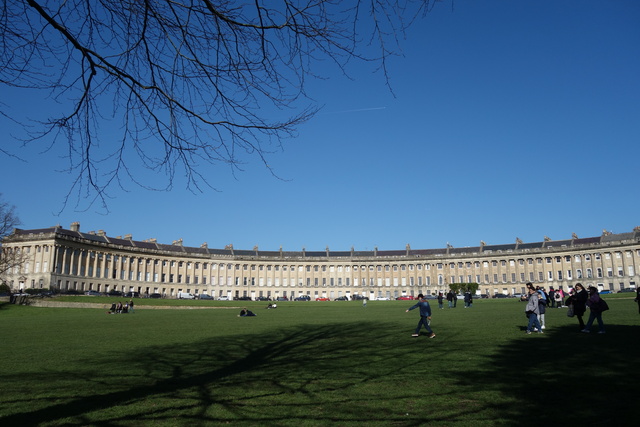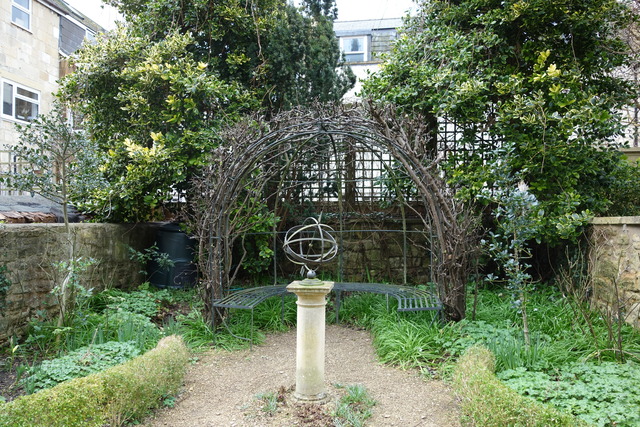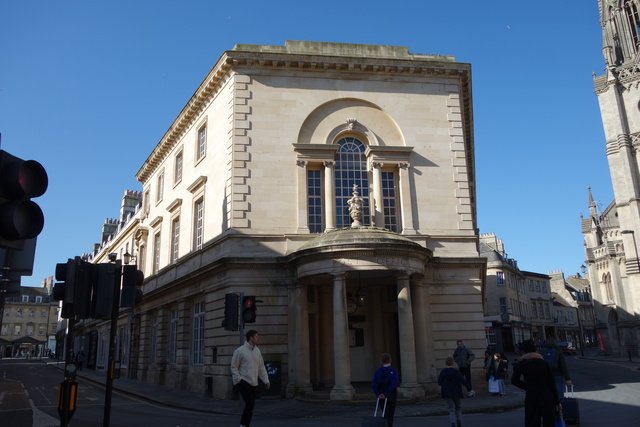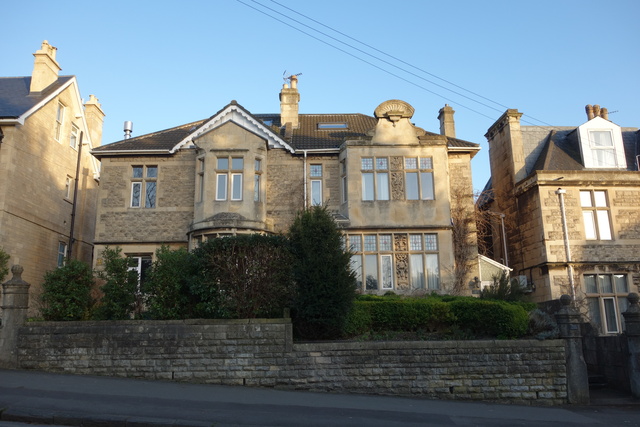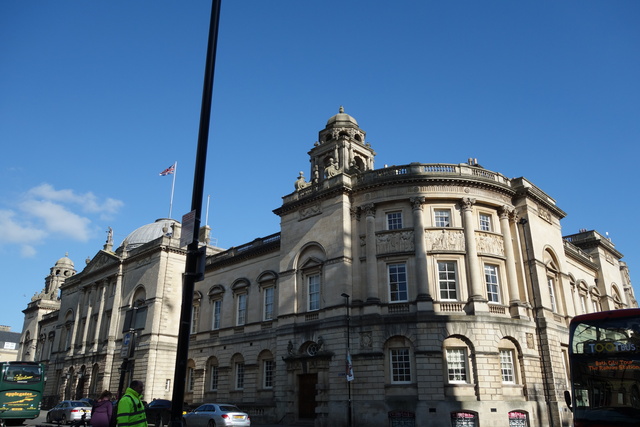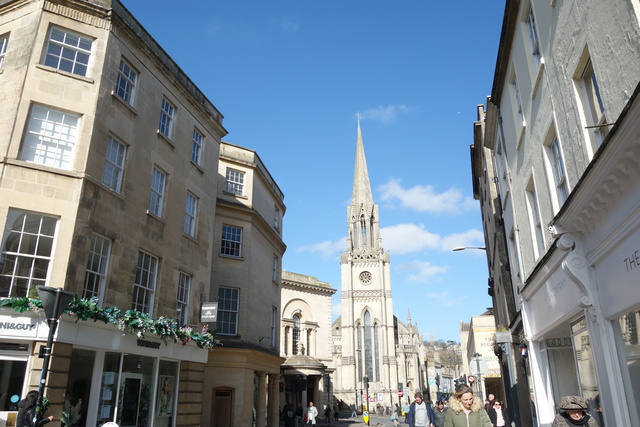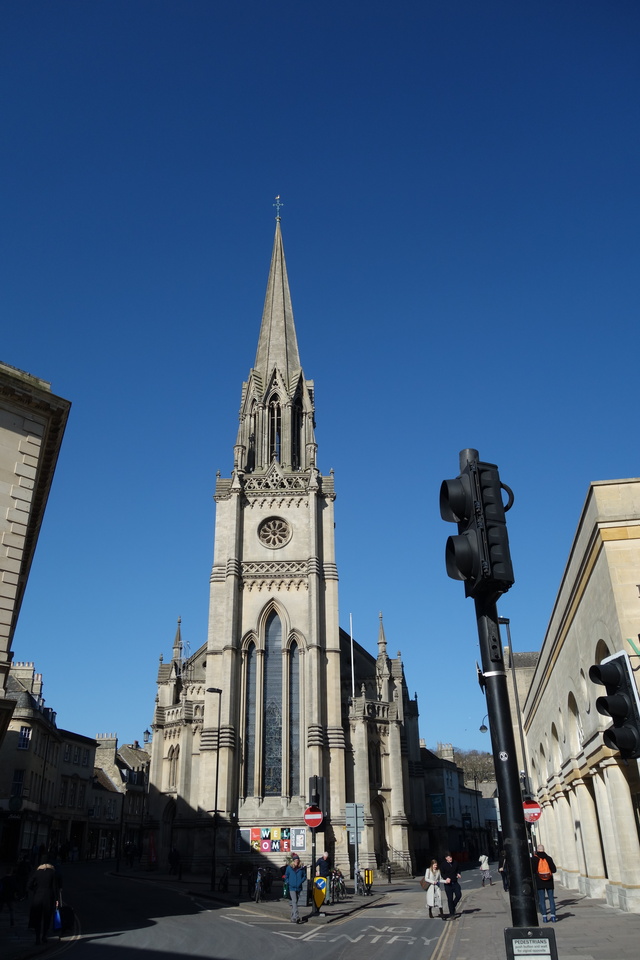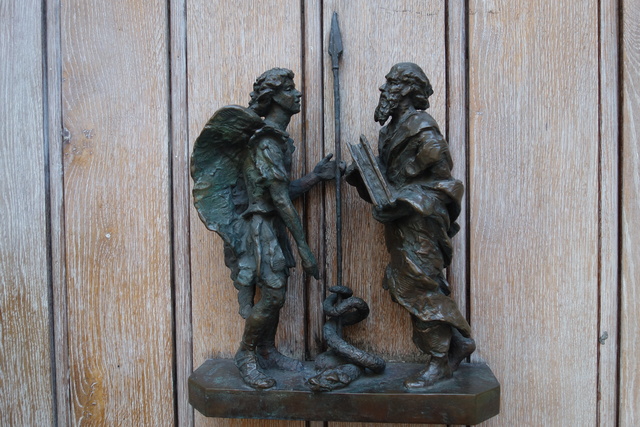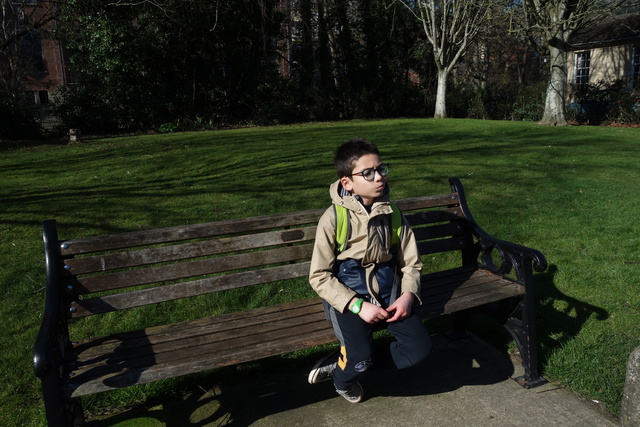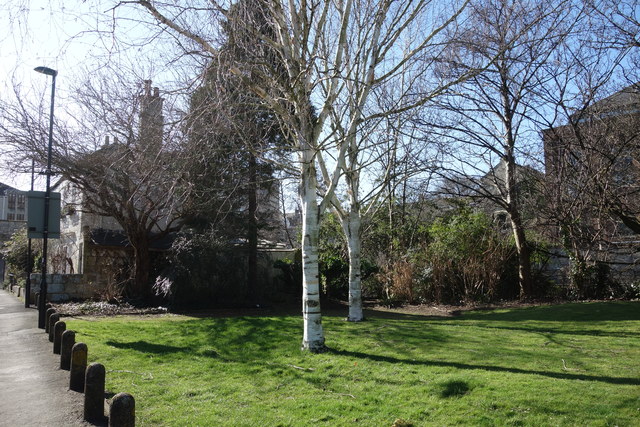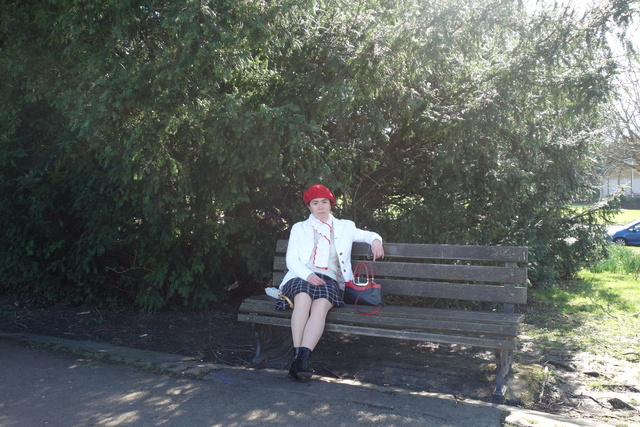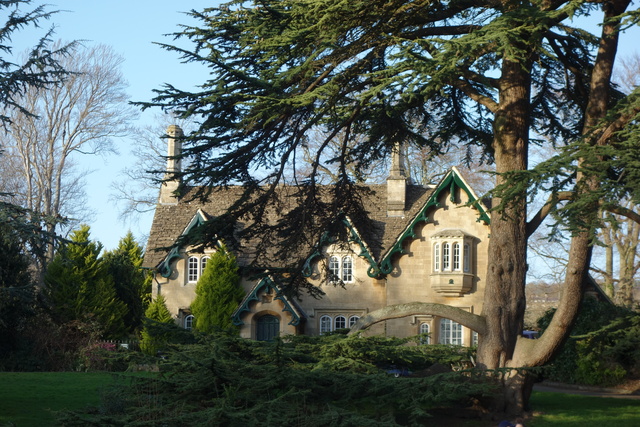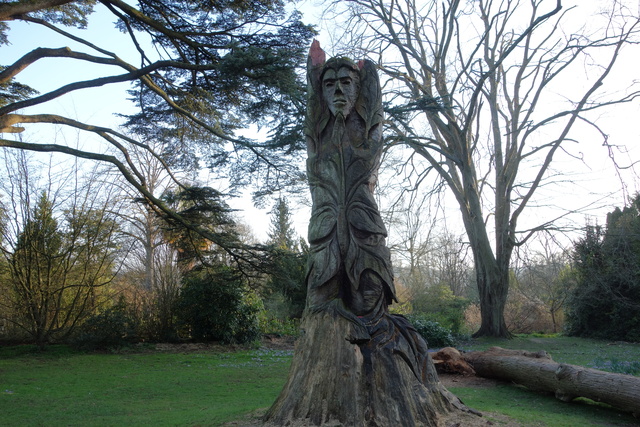On an unexpectedly sunny day at the very end of February, we jumped on a train and headed for Bath – a small town that shares with Reading the same straightforward approach to naming and relatively little else otherwise. One short hour away to the west of Reading, the building stone turns from mostly red to pale yellow, famous names and people are pushed to the forefront quite literally at times (the Roman emperors are made to guard the baths in statue form while Jane Austen guards the pavement in lifesize puppet shape), the architecture turns ambitious and claims high pride while nevertheless selling itself as much as it can. And everything gets otherwise quite tightly packed in the very centre of the relatively small town, despite there being otherwise seemingly enough space around, especially on the lovely hills that gently surround it all.
In the very centre of the tourist trap, the Bath abbey stands as the most massive side of a surprisingly small square, with the actual Roman baths that gave the town its name rather crowded and effectively built over for show, to its left. The abbey itself is the relatively usual Gothic affair, weather-eaten on the outside but well preserved, clean and even shiny on the inside. If anything, it’s perhaps less austere than some other churches around here, as it sports quite a few panels of stained glass – vividly colourful at least, even if nothing special otherwise. Outside, on the front of the abbey, there are chipped angel figures running up and down the ladders to Heaven and if some of them have tumbled down head first, it doesn’t seem to matter in any way. Inside, there are neat stone fans running across the whole ceiling and a sparkling shiny organ presiding over it all. There’s a whole lot more shiny and sparkly applied rather liberally and seemingly indiscriminately to altar cloths and the like, fitting at least the child’s current taste in decorations. Basically it’s all like a bigger and better Christmas tree from his point of view and I’d say it’s a valid way to look at it all, too:
To the right of the abbey, there’s a row of souvenir and gifts shop, while to the left there is the complex built on top of the former Roman baths. To some extent it fits perhaps with the rest at least, as there is some overall shape to it all and if I don’t find it to be Roman in the least, it’s possibly simply that I’m asking, as usual, for what it once was or at least for what remained of that instead of any ersatz. To a tiny extent, I get at least a bit of my wish: deep down and literally under the whole of what seems at first look to be the baths (apparently the street level in Roman times was quite a few meters below the current street level), there are still the bits and pieces that endured somehow through all the successive stages of use, disuse, abuse, reuse.
Such pieces as were found and otherwise the outlines and general designs of the rooms themselves are quite well presented and shown together for the best effect with a clear aim to give as much as possible an idea of the life in and around the settlement rather than narrowly focusing on the functioning of the public baths. People threw coins into the water, then as now, and wanted their names and station remembered if at all possible, then as now. Some came to the baths to bathe, some to steal, some to ask the gods for the return of stolen items and for the punishment of the suspected or even the strongly-believed-to-be-thief. Possibly the only difference between the papers left today in the church’s box and the tablets left back then at the old temples is one of tone and essentially extent of allowed freedom of speech – the old gods were apparently less restrictive, accepting requests for both blessings and curses, allowing just about any tone one cared to use. Overall though, then as now, when confronted with a problem they couldn’t solve themselves, people appealed to some greater power and at least at times, the wording of such appeals suggests they quite expected their appeal to be effective indeed, regardless of anything else.
Despite the disappointment of that ersatz of a building with a gallery of added statues of emperors put on sentry duty at the public baths on top of it all and despite the annoying abundance of shiny red interdictions to touch or have anything to do with the water on show (which is indeed rather uninvitingly greenish, apparently due to algae that are entirely a problem of the modern setting, not at all an artefact of the original baths), the part underground, where one finally gets closer to the remains such as they are, was worth seeing. And if anything, it’s probably the merit of the detailed attempt to set the found remains within a wider context that there was indeed some longing to be able to walk through the remains such as they were rather than through the later reimagining of “something Roman” while utterly ignoring at that what was even known of the original setting – if only they restored the original design that had been functional, too, not meant only for show (it even had statues, at that, only they were those of the gods, not of emperors but in those times even the gods were closer apparently to mere mortals for their statues were actually in the water, not looking on from high up). Still, for all the Greek inscription carved in the stone of the later-day building turned central restaurant, the original baths, temple and the whole settlement or town itself seem to have been quite an interesting blend of everything really, with the local and the Roman gods linked together into the Sulis Minerva name, with visitors and workers from as far as the Levant, with a temple pediment that features a male face of Minerva and a mixture of symbols – though not even a trace of Greek writing whatsoever:
Slightly off-centre, inside the Victoria Art Gallery, a few beauties in white marble venture forth, seemingly in an attempt to escape from the awful combination of a red fire sign, an iron central heater and the sash window background. One of them is bolder, the other one more cautiously peering around the marble column but both stuck in place nevertheless:
Still close to the centre, there is the New Theatre Royal building with its balcony on top of a building that seems rather too small for such a big name. Not far away from it, a less squarish and taller building claims in carved stone a less royal although funnier name that tends to be around here the trademark of a Thai restaurant chain: the giggling squid.
Beyond the “must see” baths and abbey, the town’s point of pride is its georgian architecture. The Gay Street goes steeply up until it turns at the very top into the Circus – and once there, one realises that this fabled georgian architecture means in practice simply long rows of the same window repeated ad nauseam, whether in long parallel lines or in semi-circular endings capping the avenues. The desired effect is one of greatness and in a severely narrowed perspective, if I squint until my eyes hurt, I can just about see it. On long avenues, there is at least the pleasant effect of perceived abundance of space but funnily enough, for all the clearly desired uniformity of this architectural style, nature still refuses to play ball with it and turns it all instead in a marked play of opposing contrasts, one side basked in light while the other is submerged in the shadows. Moreover, behind the back of such streets, human nature plays even more roughly with it and sprouts such a huge sprawling of mismatched everything as if to fully counterbalance the pretense of perfect uniformity that the facade holds so dear. Oh, and on a side note, let it be said also that the Roman plumbing at the baths is still satisfactorily working today, while the phrase “georgian plumbing” was used disparagingly by every restaurant owner that I met while in town 1.
On a side street, one of the windows in a row holds however a bit more behind it than the rest – the house is where a German called Herschel settled at first to give music lessons and ended up in quick order building telescopes, discovering new planets and speculating on the composition of nebulae. As a result, the world nearly ended up with a planet called George (a kingly name, don’t scoff at it!) but in the end it all worked out for the best – Herschel got the king’s attention and with it funding to further pursue his astronomy interest where he made more advances than in his music career and the planet still got in the end a name more in tune with the other planets’ names: Uranus. On a side note, it was in this museum that I found out just why exactly is an orrery called that: because it was the Earl of Orrery who commissioned the first such thing to be made, as simple as that. On the other hand, I still have no idea why was the title itself called “Orrery” since the earldom was of Cork and the surname was simply Boyle. Supposedly there is some older Gaelic word linking it all to some meaning but it’s all getting rather very fuzzy indeed from this point on so I’ll leave it at that and be thankful that it wasn’t the Earl of George to commission that first model of the solar system.
Leaving aside the baths, the circus and the neverending rows of windows, the town’s buildings tend to be relatively squarish although retaining some of the Roman villa style at times, quite often with a rather pleasant effect. Some have rounded corners with ornate carvings and even cleaner stone that makes it all look quite pretty indeed.
A bit further away from the abbey, standing at a three-roads intersection of sorts, there’s a more slender church with a narrow spire and the best church door handles that I ever saw, basically a depiction of saints in such a genuinely alive manner that it made me think yet again of Caravaggio and his futile quest to get official recognition for genuine life representations:
Besides the above door handles, the church has a rather puzzling but fitting name: Saint Michael Without. The clue to the puzzle is in the older meaning of without – not as much a lack of something as merely a positioning by contrast to within, meaning thus simply outside of the town’s walls, because apparently at the time when it was built, this church was indeed outside the official walls. Fitting handles therefore, I should think, with the two saints not as much concerned with their sainthood as rather humorously pointing to one another their respective interests, it seems to me. Judging by the spear held by one and the book held by the other, I’d guess them to be St. Michael and St. Paul but first of all they seem to me like a pair of good friends who care for one another even though they have quite different approaches and interests: teasingly if good naturedly pointing out what they each perceive to matter most, while willing to look at least at what the other is pointing at, even if not really wishing to touch it. Still, for entering the church, it sadly turned out that spear *and* book are not even enough – one needs a key too, so perhaps St. Peter should have joined in, as well.
Even further away from both the centre and the former “without” area, the streets open up to the surrounding greenery and there is an even more peaceful air to it all. We walked around the town several times to the point where we knew our way without any map and if benches ended up in the pictures, too, it’s simply because they were at the right place to have a break, nothing more than that. Other than benches though and to my pleasant surprise, we even found birch trees right in town and close to the river. And in the rather small area called the botanical garden, there was a trunk carved as a human figure – without arms, it is true, but what would he need the arms for, anyway?
- Speaking of restaurants, we found this Italian place that could have equally been in Napoli for all one knew once inside. Everything, from food to setting and people were as authentically South Italian as it gets and combined with the sun shining through a skylight that showed, dust and dirt notwithstanding, a whole jumble of inner courtyard architectural outgrows that would have been perfectly at home in Rome, it all had the predictable effect of my talking switching at times to Italian before I quite knew it – not that anyone complained of it at all. The child didn’t care much for language or for setting but was utterly delighted with the food and even more so with the gelato, of course.[↩]
Comments feed: RSS 2.0
